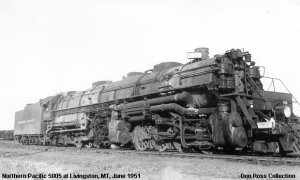The N&W Mallets pounded the rails at speeds above 40 mph, and so they were restricted by the management to slower drag speeds. Fortunately for alcon, that worked out the best. Any time you have massive reciprocating and eccentric weights circling small drivers, which the Y's had, where there is so little counterbalancing mass able to be applied effectively in the smaller circumference, you get high dynamic loading on the rails which literally pulverizes the ballast (not a good thing), splits ties, and bends the rails...also not good things.


